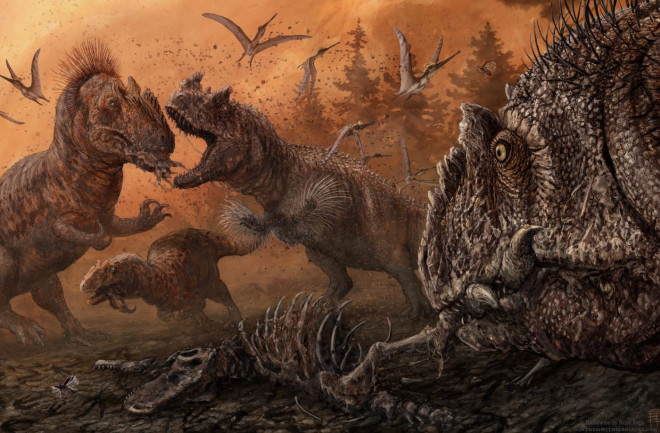Theropods – the family of dinosaurs that included the mighty Tyrannosaurus rex and the smaller Allosaurus – had the largest and most sophisticated brains of any such dinosaur group. But scientists aren’t sure how they used these advanced faculties, whether for hunting or tracking down the next corpse to scavenge.
A 2011 study found that if you set loose a group of scavenging T. rex’s in an environment comparable to the Serengeti in Africa, they would struggle to survive. But a new study has concluded that theropods living alongside massive sauropod dinosaurs, such as the Brontosaurus, would have had access to a smorgasbord of dinosaur flesh, more than enough to sustain them for years on end.
Virtual Dinosaurs With Virtual Appetites
The researchers conducted a computerized “agent-based model” in which Allosaurs – a predatory dinosaur like T. rex – wandered around a doughnut-shaped world populated by living prey (modeled after Stegosaurus) and dead sauropods. Many of the Allosaurs enjoyed a lush life feeding on the caloric bounty of the latter. Even a smaller sauropod weighing 11 tons was enough to sustain a single Allosaurus for 150 days.
The monumental carcasses likely remained on the real-life Mesozoic landscape for months at a time, if not years. Allosaurus and other theropods could have fed generously and stored the extra fat in their tails, as modern-day reptiles do. To the researchers’ surprise, the virtual “genes” increasing tail storage proved to be the most useful for the virtual predators.
“Allosaurs probably waited until a bunch of sauropods died in the dry season, feasted on their carcasses, stored the fat in their tails, then waited until the next season to repeat the process,” the researchers said in a statement. “This makes sense logically, too, because a single sauropod carcass had enough calories to sustain 25 or so Allosaurs for weeks or even months, and sauropods were often the most abundant dinosaurs in the environment.”
Read More: Scientists Unearthed a Meat-Eating Dinosaur in Argentina Named 'One Who Causes Fear
Was T. Rex a Scavenger, Too?
Allosaurs likely began their lives hunting opportunistically for smaller, living prey and stepped up to carrion feeding later in life. They used weaker jaws better suited to eating carrion, a trait common to all areas where sauropods lived. T. rex had stronger jaws but largely lived in areas without the titanic herbivores.
Whatever the two dinosaurs ate, they did so with distinctive styles, according to a 2013 study that simulated each species’ musculature using techniques from robotics. While Allosaurus ate in a precise, raptor-like manner, T. rex “was like an angry gorilla with an ice pick,” one of the researchers told The New York Times.
Read More: The Top 7 Scariest Dinosaurs the World Has Ever Seen

